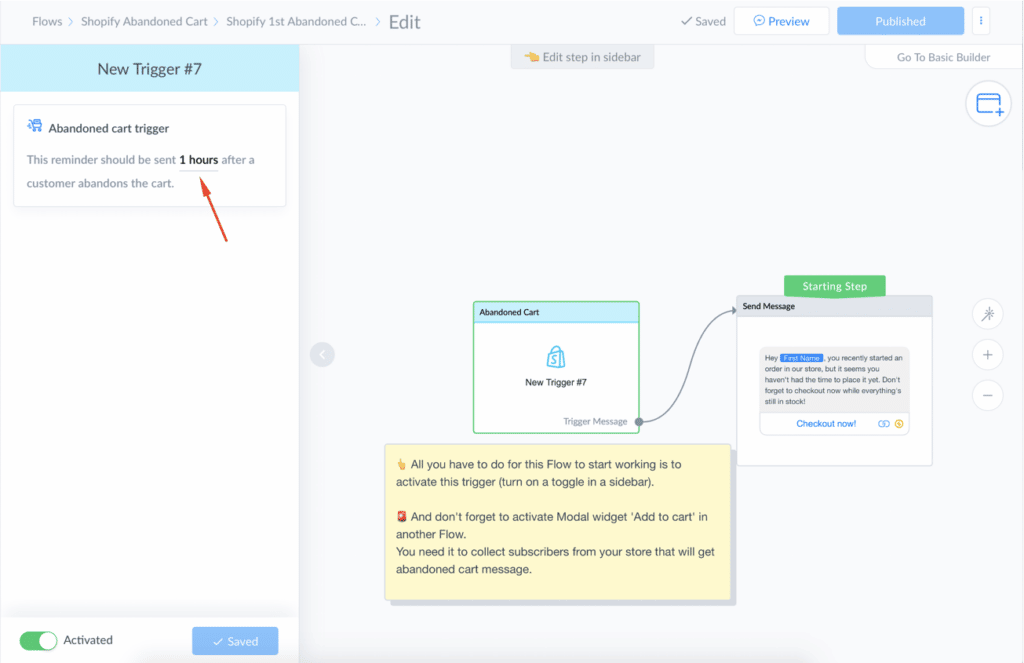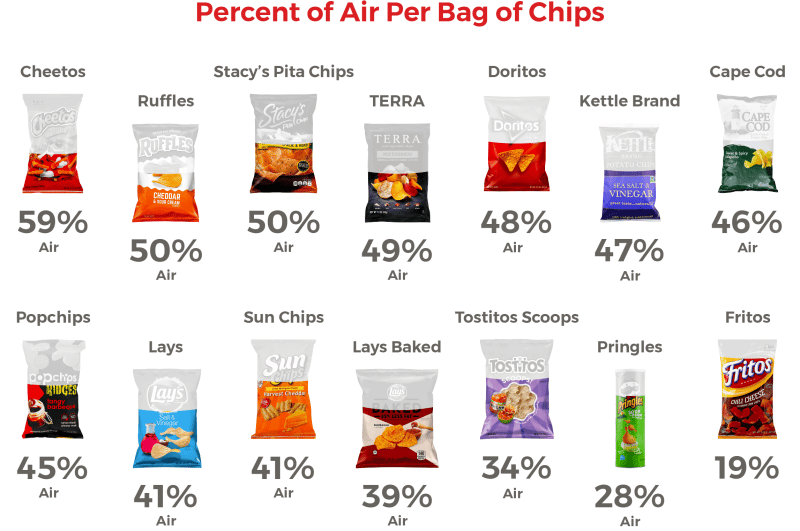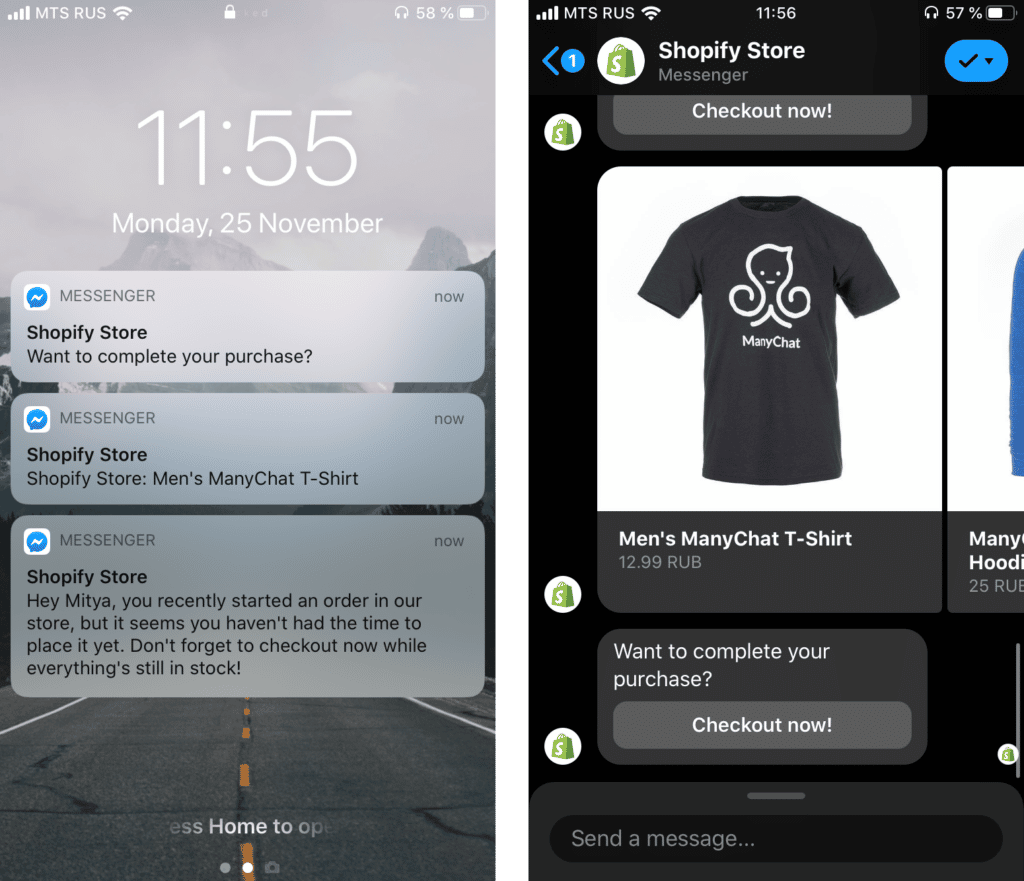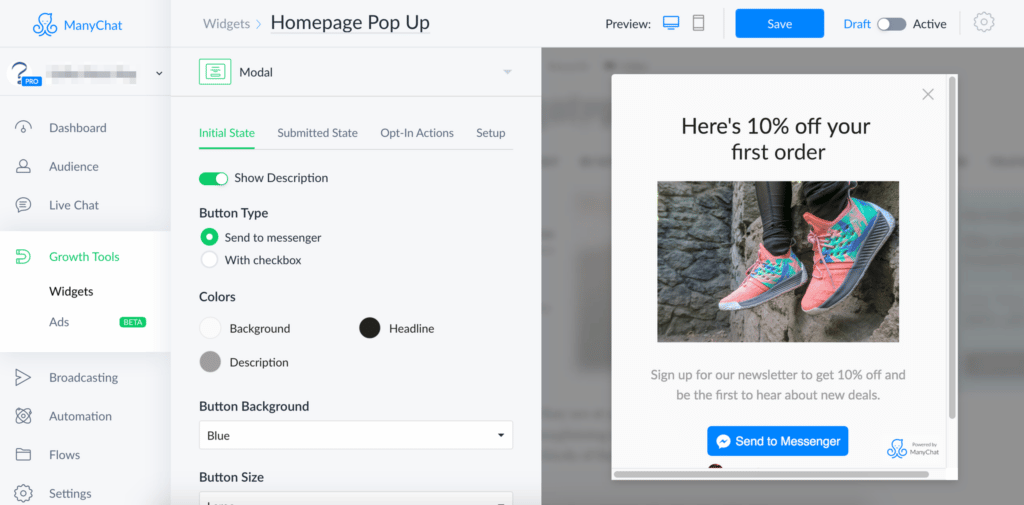Here’s the truth about creating an efficient eCommerce Marketing strategy: it’s pretty complicated.
Read any guide to eCommerce marketing strategies, and you’ll come across a bunch of “simple” and “easy” things that’ll (maybe) drive more revenue.
… If only it were that easy.
If you’re serious about creating a profitable eCommerce marketing strategy, you need to be smart in how you build a community on social media and retain customers.
Otherwise, you’re doing what everyone else is doing: spending countless dollars on cold leads and people who don’t care about your product.
So, ready to see how you can improve your online marketing strategy? Check out these top 16 eCommerce marketing tips.
16 eCommerce marketing strategies to maximize engagement and boost online sales
- Create content that visualizes your product
- Invest in Chat Marketing
- Use viral giveaway marketing campaigns
- Send exclusive deals to existing customers
- Employ conversational Facebook Ads
- Promote organic posts
- Build community around your brand
- Include automation
- Optimize product pages for SEO and design
- Use infographics
- Prepare your holiday season strategy
- Set a budget for Product Listing Ads on Amazon
- Improve your abandoned cart recovery
- Run video ads on Facebook
- Up your customer service game
- Turn store visitors into subscribers
1. Create content that visualizes your product
This is an important point.
People can’t touch your products or see them in person when shopping online. So in turn, you want to find engaging ways to present products so people can get a feel for them, both on your e-Commerce site and on social media.
It replicates seeing the product in-store and helps shoppers make more informed buying decisions than a single image.
Research also shows that interactive content generates twice the amount of conversions than static content. A high conversion rate is where quality, interactive content really shines, especially when combined with the right inbound marketing approach.
For example, many eCommerce sites use a zoom option so shoppers can see more details about the product.
Or create product videos that show potential customers the item in action like Training Mask 3.0
If you want to sell more online, figure out how to bring your product to life digitally. Learn more by reading these tips on how to create eCommerce product videos.
2. Invest in Chat Marketing
Chat Marketing is the act of using chat platforms to start conversations and commerce with prospective customers and loyal ones.
It’s an essential mix of marketing channels because only about 15% of people will open your email, and 2% click-through. There’s lag time, limited post-click activity, and high unsubscribe rates.
A Chat Marketing strategy — which combines Messenger, SMS, and email campaigns — will help drive new revenue and retain customers. With Messenger, almost 80% of people open your message, and 56% click-through. 98% of people open SMS messages with a 19% click-through rate.
Whether it’s slow sales day, end of month specials, abandon carts, or promoting a big sale — you can launch a campaign with little investment.
3. Use viral giveaway campaigns
When you’re looking to spread the word quick, viral campaigns are a smart way to do it.
Sharing relevant giveaway content with friends has become easier, thanks to Messenger.
Why? Well, friends share stuff with their friends when it’s fun and engaging.
A good eCommerce marketing strategy example is the Yava Fitness Centers and ManyChat + Viral Loops campaign.
The giveaway gathered nearly 35,000 subscribers for Yava Fitness Centers.
It was to the point, enticing, and only took two clicks to share with a friend.
Here’s an example of the conversation that drove 48.8% of participants from Messenger referrals:
Read more about the Messenger Referral case study here.
4. Send exclusive deals to existing customers
No matter what strategy, tactics, or software you use, there’s one universal truth:
Repeat customers help grow your online store, and more importantly, generate more revenue at a lower cost.
But how?
If it sounds complicated or daunting, here’s something to think about — chances are, they’re already going to buy from you. It’s just a matter of sending them the right deals at the right time.
Reward customer loyalty by sending them special discount codes, weekly deals, or offers. Keep it simple: send a personal follow-up in Messenger or with an SMS message to show appreciation.
A few good times to send these are:
- After the first purchase
- When someone makes a certain amount of purchases
- If they haven’t purchased in a while
- Personal events like birthdays or holidays
5. Deploy conversational Facebook Ads
Conversational Facebook ads are a surefire way to increase return on ad spend and drive online sales.
Basically, it’s an automated conversation you have with someone to get their information, offer something, or recommend a product.
You can send them as Click-to-Messenger ads or Sponsored Messages, all on autopilot, too.
It’s a cost-effective way to engage with potential customers, capture leads (either via SMS, Messenger information, or even an email list), and qualify them for your funnel.
Because everything happens in Messenger, keep your ads conversational, friendly, and interactive to see results.
Here’s an example of a conversational ad to get sign-ups for a HubSpot webinar:
6. Promote organic posts
Facebook advertising is a huge eCommerce topic.
The main goal with Facebook advertising is to ensure that targeted people to click your ad and buy something. But creating that perfect ad is hard, and doing it wrong can affect everything from placement to cost per click.
To be honest, most eCommerce marketers don’t need to worry about making ads from scratch.
Simply use organic posts from your Page that performed well, and target them to a specific audience.
It’s the approach that MVMT, a small luxury watch brand, took to generate over $90M in revenue in five years through Facebook ads.
7. Build community around your brand
Start a Facebook Group where your target audience can come to share information and interests or discuss concerns. Then, create content around those conversations to help out or inspire them on social media.
In saturated industries like beauty or discount retail, it’s hard to carve a space for your company.
But have no fear — the community is here to help you build awareness and sell more to the right people.
Frank Body’s built a community around women (or as the brand refers to as “babes”) who want to show their natural selves, have fun, and enjoy their beauty products.
In an industry dominated by influencers and celebrities, this type of community on social media is rare. But it can significantly boost your digital marketing efforts. After all, influencer marketing is nothing to scoff at!
The result? Annual sales of $20M and counting.
8. Include automation
Personalize your marketing and send customers the right message, at the right time. By using marketing automation in your store you can:
- delight customers by sending helpful product follow-ups
- collect customer feedback
- re-engage with cold customers
- send fulfillment messages
- increase average order value
For example, with ManyChat’s Shopify integration, you can build an automated abandoned cart flow to recover lost sales:

With ManyChat’s chat automation tools, you can talk to your customers anytime, anyplace, and on the channels they’re most comfortable on: Messenger, SMS, and email.
Boost sales in your online store with ManyChat. Sign up for free today to get started.
9. Optimize your product descriptions and pages for SEO and design
Optimizing your product pages for a given search engine, from keyword research to technical SEO to link building, can drive more targeted traffic and potential customers from your choice of search engine.
Start with a product title based on what people are searching for online. Tie that same keyword into your description and meta, then keep an eye on how you perform in search.
Bonus points for HD photos, product videos, trust badges, and shipping details too.
eCommerce is getting faster and happening on a ton of different platforms and devices. An effective inbound marketing plan can help boost revenue for your eCommerce business alongside these strategies.
10. Use infographics
Ecommerce infographics can be a great way to keep people informed about the latest trends. You may think infographics are a little past their time, but according to a 2018 study by Moz, they still generate more links than other content types.

For example, the following infographic created by Kitchen Cabinet Kings went viral on Reddits r/dataisbeautiful.

According to CXL, the infographic generated nearly 100 backlinks for the eCommerce website, including media mentions and increased brand awareness due to it’s virality.
Not sure where to start? We recommend reading How to Make an Infographic in 5 Steps to create an infographic that engages and educates your customers.
11. Prepare your holiday season strategy
If you’re going to put a good deal of energy into your Q4 marketing plan, you’ll want to prepare to sell during the most profitable time of the year.
To create an effective seasonal eCommerce marketing plan, you will need to set goals. Most eCommerce owners are comfortable with putting money into paid ads with little consideration, but the most successful set goals that help them stay on budget and generate sales.
Do you want to get rid of old stock? Increase sales? Decrease abandon cart rate?
There are many things to consider when putting together your marketing plan:
- What holidays will you promote for? Some may focus on before Christmas flash sales, while others will promote for Cyber Monday, Green Monday, Black Friday, and more. Dig into your historical sales to determine where to put your spend for the season.
- How much should you spend? While the numbers vary business by business, a good baseline is roughly 10% of your yearly budget. This covers costs for ads, creative assets, social media like Facebook and Instagram, content, and other marketing costs. Instagram Ads, for example, are an extremely potent tool for any eCommerce store looking to increase its footprint. Shoppable posts are a great way to illustrate this point — they draw customers into the sales funnel and allow you to engage in future retargeting.
- What content will you create? Jumping the seasonal content trend is a convenient and affordable way to bring in eCommerce sales. It can be helpful to make your content beforehand so you can focus on handling this busy season.
Oh, and don’t forget about lots of Santa GIFs and holiday Messenger bot themes!
12. Set a budget for Product Listing Ads
In creating your channel strategy, be aware of Product Listing Ads (PLA’s) on Google and Amazon. PLA’s are growing faster than text ads, accounting for over 52% click share in recent Q4’s.
And when you consider 9 out of 10 customers check Amazon even if they find a product on another retailer’s site, setting some budget aside for paid Amazon ads can help feed the top of your eCommerce sales funnel.
13. Improve your abandon cart recovery
A new study from Salescycle shows that 79.17% of shoppers abandon cart in online stores. And every time a customer abandons their cart, you lose a sale.
But it doesn’t have to be this way. Messenger Marketing is proven to recover more revenue and get higher response rates than email.

Gustavo Boregio, Founder of Engi Marketers, adds to this:
“The abandoned cart sequence alone will pay for the investment several times over. If you add automated customer support, paid marketing campaigns and content marketing you’ll have a scalable, high-converting money-making machine.”
To reduce abandon carts in your store, you can also:
- make sure there are no hidden costs at check out
- send a follow-up Messenger conversation, text, or email after 24-hours to encourage customers to return
- personally reach out in Live Chat and see if there’s anything you can do
- remarket to them using a Facebook custom target audience
Read more: 4 Cart Abandonment Solutions to Recover More Sales
14. Run video ads on Facebook
As an eCommerce marketer, you want to advertise your product in the best way. Create videos to use for social media, Messenger, email, retargeting, and advertising to boost revenue.
For example, you can use Facebook Collection ads to showcase both video and image:
The Adidas ad above saw a 43% decrease in conversion cost and 5.3X return on ad spend. A creative eCommerce marketing plan that involves product video can help your online store compete in the marketplace.
15. Up your customer service game
Businesses lose an average of $75 billion each year because of bad customer service. The key to successful service is to make everything as easy and convenient as possible for shoppers. Product guides, seamless purchasing, and responsive support are a few areas to focus on, and it doesn’t have to break the bank.
Chatbots provide the added bonus of being available 24/7. This is a great way to make product recommendations, upsell, and quickly answer questions that customers may have when staff isn’t around.
16. Turn store visitors into subscribers
With ManyChat, you can place a Modal widget on product pages or Add to Cart pages to capture subscribers in your store. Capturing subscribers and boosting the overall conversion rate of your eCommerce platform is absolutely vital when it comes to developing an omnichannel marketing strategy.

Create the message, timing, and placement and add it to your store or landing page. Then continue to build a relationship with them through Messenger, SMS, and email.
Start applying these eCommerce marketing strategies today
eCommerce has become a tough industry to compete in, but with a smart approach, you can tap into your target audience and sell more online.
If you’re struggling to jumpstart your online store, or sales are trending down, start applying these strategies today.












